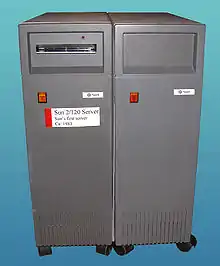
The Sun-2 series of UNIX workstations and servers was launched by Sun Microsystems in November 1983.[1] As the name suggests, the Sun-2 represented the second generation of Sun systems, superseding the original Sun-1 series. The Sun-2 series used a 10 MHz Motorola 68010 microprocessor with a proprietary Sun-2 Memory Management Unit (MMU), which enabled it to be the first Sun architecture to run a full virtual memory UNIX implementation, SunOS 1.0, based on 4.1BSD. Early Sun-2 models were based on the Intel Multibus architecture, with later models using VMEbus, which continued to be used in the successor Sun-3 and Sun-4 families.
Sun-2 systems were supported in SunOS until version 4.0.3.
A port to support Multibus Sun-2 systems in NetBSD was begun in January 2001 from the Sun-3 support in the NetBSD 1.5 release. Code supporting the Sun-2 began to be merged into the NetBSD tree in April 2001.[2] sun2 is considered a tier 2 support platform as of NetBSD 7.0.1.[3]
Sun-2 models

Models are listed in approximately chronological order.
| Model | CPU board | Display | Max. RAM | Chassis |
|---|---|---|---|---|
| 2/120 | Sun-2 Multibus or Sun-2 Multibus Prime | Monochrome | 8 MB | 9-slot Multibus (deskside) |
| 2/170 | Sun-2 Multibus or Sun-2 Multibus Prime | Optional | 8 MB | 15-slot Multibus (rackmount) |
| 2/50 | Sun 2050 VME | Monochrome | 8 MB | 2-slot VME (desktop) |
| 2/130 | Sun 2050 VME | Monochrome | 8 MB | 12-slot VME (deskside) |
| 2/160 | Sun 2050 VME | Color | 8 MB | 12-slot VME (deskside) |
A desktop disk and tape sub-system was introduced for the Sun-2/50 desktop workstation. It could hold a 5 ¼" disk drive and 5 ¼" tape drive. It used DD-50 (sometimes erroneously referred to as DB-50) connectors for its SCSI cables, a Sun specific design. It was often referred to as a "Sun Shoebox".
 Sun-2 Disk and Tape Sub-System (front)
Sun-2 Disk and Tape Sub-System (front) Sun-2 Disk and Tape Sub-System (rear)
Sun-2 Disk and Tape Sub-System (rear)
Sun-1 systems upgraded with Sun-2 Multibus CPU boards were sometimes referred to as the 2/100U (upgraded Sun-100) or 2/150U (upgraded Sun-150).
A typical configuration of a monochrome 2/120 with 4 MB of memory, 71 MB SCSI disk and 20 MB 1/4" SCSI tape cost $29,300 (1986 US price list[4]).
A color 2/160 with 8 MB of memory, two 71 MB SCSI disks and 60 MB 1/4" SCSI tape cost $48,800 (1986 US price list).
A Sun 2/170 server with 4 MB of memory, no display, two Fujitu Eagle 380 MB disk drive, one Xylogics 450 SMD disk controller, a 6250 bpi 1/2 inch tape drive and a 72" rack cost $79,500 (1986 US price list).
Sun-2 hardware
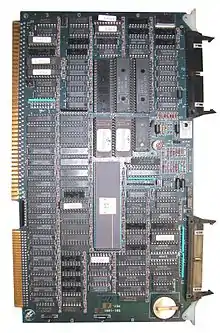
Sun 2 Multibus systems
Sun 2/120 (9 slot deskside) and 2/170 (15 slot rackmount) systems were based on the Multibus architecture. The CPU board was based on a 10 MHz 68010 processor with a proprietary Sun Memory Management Unit (MMU) and could address 8 MB of physical and 16 MB of virtual memory. The top 1 MB of physical memory address space was reserved for the monochrome frame buffer. The Multibus CPU board supported the Sun-1 parallel keyboard and mouse as well as two serial ports.
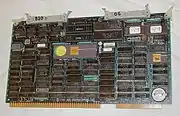 Sun-2 Multibus CPU board
Sun-2 Multibus CPU board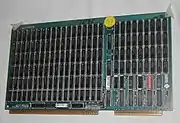 Sun-2 Multibus 1 MB memory board
Sun-2 Multibus 1 MB memory board Sun-2 Multibus Ethernet board
Sun-2 Multibus Ethernet board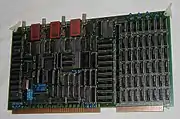 Sun-1 Multibus color graphics board
Sun-1 Multibus color graphics board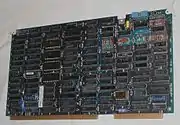 3Com Multibus Ethernet board
3Com Multibus Ethernet board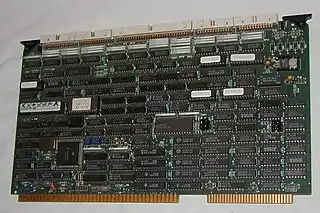 Xylogics Multibus SMD disk controller board
Xylogics Multibus SMD disk controller board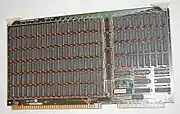 Helios Multibus 4 MB memory board
Helios Multibus 4 MB memory board
Sun 2 VMEbus systems
The Sun 2/50 (2 slot desktop), Sun 2/130 (12 slot monochrome deskside) and Sun 2/160 (12 slot color deskside) used quad-depth, triple height Eurocard VMEbus CPU boards. The VMEbus CPU board was based on the same design as the Multibus CPU but also included 2 MB or 4 MB of memory, the Sun-2 monochrome frame buffer, and 10 Mbit/s Thick Ethernet on board.
Sun provided 1 MB Multibus memory boards and 1 MB and 4 MB VMEbus memory boards but only supported configurations with a maximum of 4 MB RAM. Companies such as Helios Systems also made 4 MB memory boards that would work in Sun systems.
A common frame buffer was the Sun-2 Prime Monochrome Video. This board provided an 1152x900 monochrome display with TTL or ECL video signals, and keyboard and mouse ports. It normally occupied the top 1 MB of physical memory address space. There was also a Sun-2 Color Video board available that provided an 1152x900 8-bit color display. This board occupied the top 4 MB of address space.
42 MB MFM disks were commonly used for storage. Two disks could be connected to an Adaptec MFM/SCSI and then to a Sun-2 Multibus Serial/SCSI Host Adapter. The SCSI board provided two additional serial ports. For larger storage requirements, 65, 130, and 380 MB SMD disks were connected to a Xylogics 450 SMD Controller. The SMD controller could support four disks even though Sun only supported two. A 20 MB QIC tape drive could be connected through an Archive QIC/SCSI converter. The system also supported 1/2" tape drives connected to a Computer Products Corporation TAPEMASTER or a Xylogics 472 board.
An Ethernet connection was provided by a Sun board based on the Intel 82586 chip, or a 3Com 3c400 board. The server could support diskless Sun-2/50 clients through the Ethernet board.
Other supported Multibus boards included the Sky Computer Floating Point Processor, Sun ALM (Asynchronous Line Multiplexer) with 8 serial ports, and Sun SunLink Communications Processor (SCP) for SNA and X.25 connectivity.
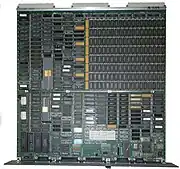 Sun-2 VME CPU board
Sun-2 VME CPU board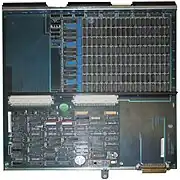 Sun-2 VME 1 MB Memory and SCSI board
Sun-2 VME 1 MB Memory and SCSI board
Reception
BYTE in August 1984 described the Sun-2/120 as a "VAX-class machine", with "superb graphics and excellent response time under loading".[5]
See also
Sun timeline

References
- ↑ "Sun Unveils 32-Bit Workstation". Articles from the Past 25 Years. November 7, 1983. Archived from the original on 2009-08-13. Retrieved March 11, 2014.
{{cite book}}:|work=ignored (help) - ↑ "NetBSD/sun2: Frequently Asked Questions". netbsd.org. January 1, 2013. Archived from the original on March 11, 2014. Retrieved March 11, 2014.
- ↑ "Platforms Supported by NetBSD". NetBSD.
- ↑ Sun U.S. Price List, End User and OEM Version, Effective March 25, 1986, Sun Microsystems
- ↑ Hinnant, David F. (Aug 1984). "Benchmarking UNIX Systems". Byte. Vol. 9, no. 8. pp. 132–135, 400–409. Retrieved 23 February 2016.
External links
- The Sun Hardware Reference, Part 1
- The Sun-2 Hardware Reference: Part 1 Archived 2007-09-27 at the Wayback Machine and Part 2 Archived 2007-09-27 at the Wayback Machine
- soupwizard.com Sun-2 Archive
- Sun2 Review from UNIX/WORLD October 1984
- Sun 100u with Sun2 boards
- Sun 2 board manuals
- gunkies.org Sun-2 wiki
- The Machine Emulator (Sun-2 Emulator running on NetBSD)